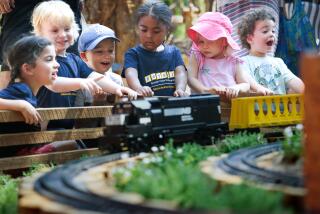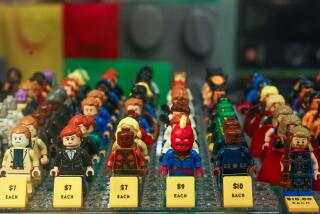SEAL BEACH : He’s on Right Track With Vintage Trains
- Share via
It began with one model train set 10 years ago.
Millard (Doc) Dokmanus was “stressing out” at his job as a telephone company representative and was looking for a hobby that would help him cool down.
“I had a train set when I was growing up,” said the 44-year-old Seal Beach man. “It reminded me of the fun of that time as a youngster.”
In the last decade, Dokmanus has collected thousands of trains as well as other “antique toys” such as miniature cast-iron cars from the 1920s and battery-operated robots from the 1960s.
In the process, he discovered a lucrative sideline as a promoter of antique toy shows, where he said “baby boomers” like himself flock to buy and sell the fond reminders of their youth.
“I guess everyone wants to recapture the old days,” Dokmanus said. “These toys give them comfort. The corporate world can be so stressful. The toy world is so relaxing.”
Much of Dokmanus’ collection is stored inside his Seal Beach home. Friends have said entering his home is like “going back in time” because of the memories sparked by the assortment of relics.
He said his collection is so extensive that he hasn’t seen some items in six years. At the heart of it are his model trains, including some that are in mint condition.
“In the 1950s and 1960s, if you got an electric train, it was like getting the best gift in the world,” Dokmanus said. “It was what all the boys wanted. You could buy accessories and buildings and create something.”
The most valuable train sets are unused ones still in their original boxes. Especially popular are 1950s American Flyer and Lionel brand trains with their colorful and detailed designs etched onto the plastic cars.
Dokmanus said the plastic trains can be more valuable than the tin-plated steel cars of the 1930s and 1940s--largely because they were used by children before World War II.
“Yuppie baby boomers are buying everything from the 1950s and ‘60s like wildfire,” he said. “They want items from their youth.”
Rare train sets are especially coveted. A 1950s Lionel girl’s train set, with its pastel tones and pink engine, could get as much as $8,000 today. “It was a market flop at the time,” Dokmanus said. “Very few were sold.”
Trains represent just a portion of the items on display at most antique toy shows. Trinkets ranging from tin wind-up Popeye toys made during the Depression to Flintstones and Bugs Bunny dolls from the 1960s are usually available. Dokmanus’ next show will take place March 20 at the Golden Sails Hotel in Long Beach.
“I can relate to a lot of this stuff because I grew up with it,” said Ken Zoelle, 43, one of Dokmanus’ neighbors and an admirer of his collection. “It brings back memories. I saw this model boat he has and said, ‘God! I think I had one of those.’ ”
Despite the thousands of objects he has collected over the years, Dokmanus insists his most prized possession is a train set he’s owned nearly all his life: the American Flyer his parents gave him when he was 5.
“I used it as a child so it is not in mint condition,” he said. “But I could never replace it.”
Toy Parade
Some of the more popular types of toys from the past include:
* 1920s: Cast-iron models in the shapes of clowns, elephants and cars
* 1930s: Tin windups resembling animals and cartoon characters
* 1940s: Construction toys like Lincoln Logs and Erector Sets
* 1950s: Colorful plastic train sets with detailed designs
* 1960s: Battery-operated cars and robots
* 1970s: Action figures from television and movies such as “Star Wars”
Source: Millard Dokmanus, antique toy collector
More to Read
Sign up for Essential California
The most important California stories and recommendations in your inbox every morning.
You may occasionally receive promotional content from the Los Angeles Times.














